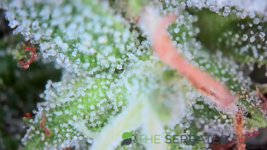itchybro
Sultan Of Soil
- User ID
- 31
you guys aware there are a few different types of trichomes yeah
& why a plants health is so important , much more important than which bottles of nutrient to use
https://trichomeanalytical.com/the-role-of-trichomes-in-cannabis-and-nature/
Trichomes are kind of a big deal around here. So much so that we named our lab after them. But what are they exactly? And what specifically are cannabis trichomes?
Simply put, trichomes are the tiny hairs or miniscule glands that are found on the leaves and other epidermal surfaces of plants. They are epidermal cells that are either unicellular or multicellular.
The term originates from the Greek word “trichoma,” which refers to hair growth. One function of trichomes is to protect plants from invasive insects, fungi and larger animals, such as rodents. The presence of the wet and sticky trichomes in plants serves as an effective deterrent to predators, regardless of whether they are herbivores or omnivores.
Some of the trichomes present on cannabis plants have even been found to be toxic to some insects. The protective natural shield also helps the plants stay healthy when exposed to harsh weather conditions and intense ultraviolet rays that could cause harm or mutation.
Trichomes are especially important for cannabis growers because they determine when it is time to harvest. A mix of cloudy and amber-colored trichomes indicates that the time is right to collect the flowers. When the trichomes get darker and become brownish in color, the cannabis buds are past their peak and need to be harvested quickly to avoid any drop in potency.
Glandular trichomes can be unicellular and multicellular, and some produce cannabinoids and terpenes. There are three types of glandular trichomes:
Bulbous Trichomes
Clocking in at just 15-30 micrometers (a human hair is about 75 micrometers), the bulbous trichome is the smallest trichome found on marijuana. It is so tiny that it is difficult to see with the naked eye. Bulbous trichomes consist of a resin-secreting gland that sits on a short supporting stalk. As it swells, the trichome sometimes forms a small bulbous protrusion on the top of the membrane. Bulbous trichomes can synthesize both cannabinoids and terpenes.
Capitate-Sessile Trichomes
Capitate-sessile trichomes are slightly larger glands (25-100 micrometers) that cover cannabis plants more densely than bulbous trichomes. These are the second most common form of trichome, as they occur on stems, leaves and bracts (modified or specialized leaves found above the leaves but below the flower). Capitate-sessile trichomes produce significant amounts of cannabinoids and terpenes throughout the entire life cycle of the plant, but at lower levels than the next type of trichomes: capitate-stalked trichomes.
Capitate-Stalked Trichomes
Capitate-stalked trichomes are the most abundant trichomes on cannabis plants. They are packed with oils and produce copious amounts of cannabinoids and terpenes. Capitate-stalked trichomes are also the largest glandular trichomes, growing as big as 150-500 micrometers. Capitate-stalked trichomes consist of a stalk and a waxy head that are visible to the naked eye. They begin to grow during the flowering phase and completely coat the area in and around the protective outer layer of small leaves that surround buds as they develop.

& why a plants health is so important , much more important than which bottles of nutrient to use
https://trichomeanalytical.com/the-role-of-trichomes-in-cannabis-and-nature/
Trichomes are kind of a big deal around here. So much so that we named our lab after them. But what are they exactly? And what specifically are cannabis trichomes?
Simply put, trichomes are the tiny hairs or miniscule glands that are found on the leaves and other epidermal surfaces of plants. They are epidermal cells that are either unicellular or multicellular.
The term originates from the Greek word “trichoma,” which refers to hair growth. One function of trichomes is to protect plants from invasive insects, fungi and larger animals, such as rodents. The presence of the wet and sticky trichomes in plants serves as an effective deterrent to predators, regardless of whether they are herbivores or omnivores.
Some of the trichomes present on cannabis plants have even been found to be toxic to some insects. The protective natural shield also helps the plants stay healthy when exposed to harsh weather conditions and intense ultraviolet rays that could cause harm or mutation.
Trichomes are especially important for cannabis growers because they determine when it is time to harvest. A mix of cloudy and amber-colored trichomes indicates that the time is right to collect the flowers. When the trichomes get darker and become brownish in color, the cannabis buds are past their peak and need to be harvested quickly to avoid any drop in potency.
Different Types of Cannabis Trichomes
There are two main types of trichomes in cannabis: glandular and non-glandular. Non-glandular appear in young plants, can be unicellular or multicellular, and look similar to hairs. They are found on branches, leaves and petioles. Non-glandular trichomes do not produce cannabinoids or terpenes. Their main roles are to block damaging ultraviolet light, store moisture, protect the plant from insects/pests and help prevent fungal infection.Glandular trichomes can be unicellular and multicellular, and some produce cannabinoids and terpenes. There are three types of glandular trichomes:
Bulbous Trichomes
Clocking in at just 15-30 micrometers (a human hair is about 75 micrometers), the bulbous trichome is the smallest trichome found on marijuana. It is so tiny that it is difficult to see with the naked eye. Bulbous trichomes consist of a resin-secreting gland that sits on a short supporting stalk. As it swells, the trichome sometimes forms a small bulbous protrusion on the top of the membrane. Bulbous trichomes can synthesize both cannabinoids and terpenes.
Capitate-Sessile Trichomes
Capitate-sessile trichomes are slightly larger glands (25-100 micrometers) that cover cannabis plants more densely than bulbous trichomes. These are the second most common form of trichome, as they occur on stems, leaves and bracts (modified or specialized leaves found above the leaves but below the flower). Capitate-sessile trichomes produce significant amounts of cannabinoids and terpenes throughout the entire life cycle of the plant, but at lower levels than the next type of trichomes: capitate-stalked trichomes.
Capitate-Stalked Trichomes
Capitate-stalked trichomes are the most abundant trichomes on cannabis plants. They are packed with oils and produce copious amounts of cannabinoids and terpenes. Capitate-stalked trichomes are also the largest glandular trichomes, growing as big as 150-500 micrometers. Capitate-stalked trichomes consist of a stalk and a waxy head that are visible to the naked eye. They begin to grow during the flowering phase and completely coat the area in and around the protective outer layer of small leaves that surround buds as they develop.
Essential in Cannabis and in Nature
Cannabis trichomes not only protect cannabis plants from insects, animals and disease, they also manage to facilitate the production of hundreds of compounds that make the cannabis plant as dynamic and nuanced as it is. Often overlooked, they truly are a remarkable aspect of an extraordinary plant.
Last edited:






